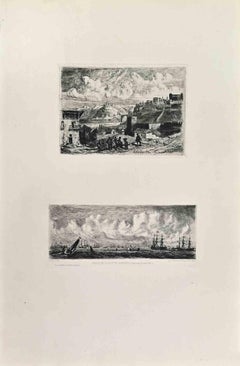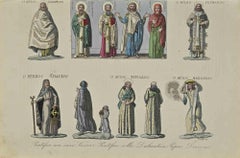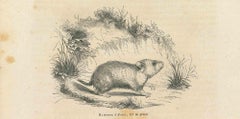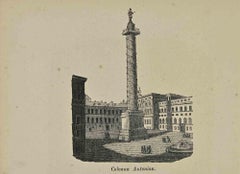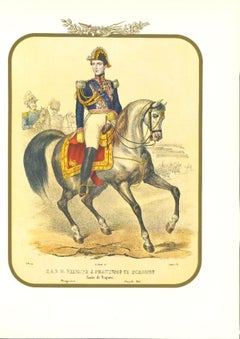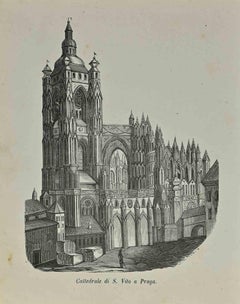Mid-19th Century Art
to
575
4,125
947
362
199
166
Overall Width
to
Overall Height
to
7,472
20,894
158,680
234,651
1,897
2,222
4,763
6,394
5,804
14,890
20,215
25,201
17,384
13,439
5,299
3,076
114
105
23
10
6
5
5
2
1
1
2,857
2,794
49
3,741
1,741
1,322
1,118
884
771
653
442
367
313
294
293
272
257
207
204
188
179
169
167
2,921
1,377
938
721
712
168
108
87
87
87
1,257
3,090
3,132
1,186
Period: Mid-19th Century
Defile de la Flotte Anglaise - Etching by Charles Elie Delprat - 1860s
Located in Roma, IT
Defile de la Flotte Anglaise is a black and White etching realized by Charles Elie Delprat in the 1860s.
Titled in the lower.
Image size: 14 x 19, 10 x 23.
Very good impression w...
Category
Contemporary Mid-19th Century Art
Materials
Etching
Uses and Customs - Saints - Lithograph - 1862
Located in Roma, IT
Uses and Customs - Saints is a lithograph on paper realized in 1862.
The artwork belongs to the Suite Uses and customs of all the peoples of the universe: " History of the governmen...
Category
Modern Mid-19th Century Art
Materials
Lithograph
Hamster - Original Lithograph by Paul Gervais - 1854
By Paul Gervais
Located in Roma, IT
Hamster is an original lithograph on ivory-colored paper, realized by Paul Gervais (1816-1879). The artwork is from The Series of "Les Trois Règnes de la Nature", and was published i...
Category
Modern Mid-19th Century Art
Materials
Lithograph
Uses and Customs - Antonine Column - Lithograph - 1862
Located in Roma, IT
Uses and Customs - Antonine Column is a lithograph on paper realized in 1862.
The artwork belongs to the Suite Uses and customs of all the peoples of the universe: " History of the...
Category
Modern Mid-19th Century Art
Materials
Lithograph
The Prince of Borbone - Original Lithograph by Antonio Zezon - 1851
Located in Roma, IT
The Prince of Borbone is an original lithograph by Antonio Zezon. Naples 1851.
Interesting colored lithograph which describes the Prince Francesco II di Borbone riding his horse, in...
Category
Modern Mid-19th Century Art
Materials
Lithograph
St. Vitus Cathedral in Prague - Lithograph by Auguste Wahlen - 1844
Located in Roma, IT
St. Vitus Cathedral in Prague is a lithograph made by Auguste Wahlen in 1844.
Good condition.
Drawing in black and white.
At the center of the artwork is the original title "Catte...
Category
Modern Mid-19th Century Art
Materials
Lithograph
Un Jour de Recompense - Etching by François Chifflart - 1860s
Located in Roma, IT
Un Jour de Recompense is a black and White etching realized by François Chifflart in the 1860s.
Titled in the lower.
Image size: 24x32.
Very good impression with wide margins and...
Category
Impressionist Mid-19th Century Art
Materials
Etching
Colossal Statues of Ramses: David Roberts' 19th Century Hand Colored Lithograph
Located in Alamo, CA
"One of Two Colossal Statues of Rameses II. Entrance to the Temple at Luxor" is a 19th century half-folio sized duo-tone lithograph from the "The Holy Land, Syria, Idumea, Arabia, Eg...
Category
Realist Mid-19th Century Art
Materials
Lithograph
Traite des Fleurs - Les Fleurs Animées Vol.II - Litho by J.J. Grandville - 1847
Located in Roma, IT
Image dimensions: 24.3 x 17.5 cm.
Single sheet with passepartout.
"...The unhappy man had approached that mysterious spot where, amid a thousand aquatic plants, the Water-arrow gr...
Category
Modern Mid-19th Century Art
Materials
Lithograph
Hieroglyphics Alphabets - Etching by Domenico Klemi Bonatti - 1850s
Located in Roma, IT
Hieroglyphics Alphabets is an Etching realized by Domenico Klemi Bonatti in the 1850s.
Signed on the plate.
Good condition with folding and foxing on margins.
Domenico Klemi Bonat...
Category
Modern Mid-19th Century Art
Materials
Etching
Tout ce qu'on Voudra II - Rare Book Illustrated by Honoré Daumier - 1850
Located in Roma, IT
Tout ce qu'on Voudra Album II is an original modern rare book engraved by Honoré Daumier (Marseille, 1808 -1879, Valmondois) in 1850.
Published in Paris.
Original Edition.
Format...
Category
Modern Mid-19th Century Art
Materials
Paper, Lithograph
Une Table Indiscrète - Lithograph by H. Daumier - 1853
Located in Roma, IT
Une Table Indiscrète (An Indiscreet Table) is a original b/w lithographed plate (n. 11) from La Fluidomanie.
This is a satiric series composed of 12 plates of caricatures “de mœurs”...
Category
Mid-19th Century Art
Materials
Lithograph
'Shepherdess in a River Landscape' Salon des Artistes Françaises, Pushkin Museum
Located in Santa Cruz, CA
'Shepherdess in a River Landscape' by Donat Guillot.
Salon des Artistes Françaises, Pushkin Museum
-----
Signed lower left, 'D. Guillot' for Donat Guillot (French, 19th Century) and painted circa 1870.
Displayed in a period and antique, carved giltwood and gesso frame...
Category
Mid-19th Century Art
Materials
Oil, Wood Panel
Le Gue - Etching by Charles François Daubigny - 1860s
Located in Roma, IT
Le Gue is a black and White etching realized by Charles François Daubigny in the 1860s.
Titled in the lower.
Image size: 30x37.
Very good impression with wide margins and a very ...
Category
Modern Mid-19th Century Art
Materials
Etching
1839-49 Joseph Nash Hand-Colored Lithograph Porch and Corridor, Ockwells, Berks
By Joseph Nash
Located in Chicago, IL
A Joseph Nash ca. 1839-49 hand-colored lithograph on paper of Porch and Corridor, Ockwells, Berks., plate from the disbound book “The Mansions of England in the Olden Time”, first se...
Category
Mid-19th Century Art
Materials
Lithograph, Paper
Uses and Customs - Forum of Athens - Lithograph - 1862
Located in Roma, IT
Uses and Customs - Forum of Athens is a lithograph on paper realized in 1862.
The artwork belongs to the Suite Uses and customs of all the peoples of the universe: " History of the ...
Category
Modern Mid-19th Century Art
Materials
Lithograph
Les Canotiers Parisiens - Lithograph by Honoré Daumier - 1843
Located in Roma, IT
Les Canotiers Parisiens is an original Modern Artwork realized in the 1843 by Honoré Daumier (in full Honoré-Victorin Daumier, Marseille, 1808 — Valmond...
Category
Modern Mid-19th Century Art
Materials
Lithograph, Paper
Italian Celebrities of 16th Century - Lithograph - 1862
Located in Roma, IT
Italian Celebrities of 16th Century is a lithograph on paper realized in 1862.
The artwork belongs to the Suite Uses and customs of all the peoples of the universe: " History of the...
Category
Modern Mid-19th Century Art
Materials
Lithograph
The Monument - Lithograph - 1862
Located in Roma, IT
The Monument is a lithograph realized in 1864.
Good conditions.
The artwork belongs to the Suite Uses and customs of all the peoples of the universe, or History of the government,...
Category
Modern Mid-19th Century Art
Materials
Lithograph
Army I Swiss Regiment - Lithograph by Antonio Zezon - 1854
Located in Roma, IT
Army I Swiss Regiment is an original lithograph by Antonio Zezon. Naples 1854.
Interesting colored lithograph which describes some members of the Army Swiss Regiment: in the foregro...
Category
Modern Mid-19th Century Art
Materials
Lithograph
Example of Doric Proportion - Lithograph - 1862
Located in Roma, IT
Example of Doric Proportion is a lithograph on paper realized in 1862.
The artwork belongs to the Suite Uses and customs of all the peoples of the universe: " History of the governm...
Category
Modern Mid-19th Century Art
Materials
Lithograph
La Pompe Notre Dame
Located in Roma, IT
This original etching is titled and dated on plate. Monogram of the artist "MC" on higher right margin. Edition of 30 prints, 9 State. Very good conditions.
Charles Méryon was a Fre...
Category
Old Masters Mid-19th Century Art
Materials
Etching
Uses and Customs - La Pons - Lithograph - 1862
Located in Roma, IT
Uses and Customs - La Pons is a lithograph on paper realized in 1862.
The artwork belongs to the Suite Uses and customs of all the peoples of the universe: " History of the governme...
Category
Modern Mid-19th Century Art
Materials
Lithograph
Kimmeridge Bay & The Clavell Tower The Purbecks Dorset Coast Framed Watercolor
Located in Sutton Poyntz, Dorset
John Bedloe Goddard.
English ( b.1838 – d.1896 ).
Kimmeridge Bay & The Clavell Tower, The Purbecks, Dorset, 1876.
Watercolor On Paper.
Signed & Dated Lower Right.
Image size 12.4 inc...
Category
Victorian Mid-19th Century Art
Materials
Paper, Watercolor
Panthere - Original Lithograph by Paul Gervais - 1854
By Paul Gervais
Located in Roma, IT
Panthere is an original lithograph on ivory-colored paper, realized by Paul Gervais (1816-1879). The artwork is from The Series of "Les Trois Règnes de la Nature", and was published ...
Category
Modern Mid-19th Century Art
Materials
Lithograph
Tourelle de la Rue de la Tixeranderie - Etching by C. Meryon - 1852
Located in Roma, IT
Tourelle de la rue de la Tixeranderie is an original Modern Artwork realized in the half of the 19th Century by Charles Meryon (sometimes Méryon, 23 November 1821 – 14 February 1868).
Original Etching.
Fine impression printed by the artist.
II/III state on V.
Total dimensions: 24 x 12 cm. Passepartout is included.
Excellent conditions of sheet.
Reference:
Salimbeni no.163;
Schneiderman n. 24;
Delteil n. 29.
Charles Meryon (sometimes Méryon, 23 November 1821 – 14 February 1868). He was a French artist who worked almost entirely in etching, as he suffered from color blindness. Although now little-known in the English-speaking world, he is generally recognized as the most significant etcher of 19th century France. His most famous works by him are a series of views powerfully conveying his distinctive Gothic vision of Paris. He also suffered from mental illness, dying in an asylum. Meryon had sketched in Athens, Algiers and other exotic places he had visited, and by late 1840 decided to take lessons in drawing from the Toulon...
Category
Modern Mid-19th Century Art
Materials
Etching
Kish-Ke-Kosh, Fox Brave: Original Hand-colored McKenney & Hall Lithograph
Located in Alamo, CA
This is an original 19th century hand-colored McKenney and Hall lithograph of a Native American entitled "Kish-Ke-Kosh, Fox Brave", lithographed by J. T. Bowen after a painting by Charles Bird King and published by Rice and Hart & Co. in Philadelphia in 1848. Kish-Ke-Kosh, means 'The Man with One Leg' or 'He with a Cut Hoof'. He had a reputation for being a fierce warrior. He was a representative of the delegation of Sioux and Fox and Sauk chiefs who attended the gathering with the War Department in 1837. The Fox tribe lived in the Great Lakes region of the United States and merged with the Sauk tribe.
This original McKenney and Hall hand-colored lithograph is printed on a sheet measuring 10.38" high and 7" wide. There are tiny spots in the lower left margin, another in the right lower margin and mild smudging in the left margin, but the print is otherwise in very good condition. The original descriptive text pages, 119-120, from McKenney and Hall's 19th century publication are included.
Col. Thomas J. McKenney was Superintendant of The Bureau of Indian Affairs from 1816 until 1830. He was one of a very few government officials to defend American Indian interests and attempt to preserve their culture. He travelled to Indian lands meeting the Native American leaders. He brought with him an accomplished artist, James Otto Lewis...
Category
Naturalistic Mid-19th Century Art
Materials
Lithograph
French romantic painting Oil on paper TANCARVILLE castle Normandy 19th
Located in PARIS, FR
Victor LEFRANC
Paris, 1812 - ?
Oil on paper
33 x 42 cm (44 x 52 cm with frame)
Inscription on the verso 'Tancarville / 1839" and stamp from the Georges Lhoste collection
Painter of ...
Category
Romantic Mid-19th Century Art
Materials
Oil
$1,719 Sale Price
20% Off
Ancient View of Gripscholm - Original Lithograph - Mid-19th Century
Located in Roma, IT
Ancient View of Gripscholm is an original modern artwork realized in Germany in the Mid-19th Century.
Original B/W Lithograph on Ivory Paper.
Inscripted on the lower central margi...
Category
Modern Mid-19th Century Art
Materials
Lithograph
Rest
Located in Genève, GE
Work on wood
Brown wooden frame
16.5 x 19 x 1.6 cm
Category
Mid-19th Century Art
Materials
Oil
$1,170
Ancient View of Carlscrona - Original Lithograph - Mid-19th Century
Located in Roma, IT
Ancient View of Carlscrona is an original modern artwork realized in Germany in the Mid-19th Century.
Original B/W Lithograph on Ivory Paper.
Inscripted on the lower central margi...
Category
Modern Mid-19th Century Art
Materials
Lithograph
The Animals in Jungle - Lithograph by Paul Gervais - 1854
By Paul Gervais
Located in Roma, IT
The Animals in Jungle is an original lithograph on ivory-colored paper, realized by Paul Gervais (1816-1879). The artwork is from The Series of "Les Trois Règnes de la Nature", and w...
Category
Modern Mid-19th Century Art
Materials
Lithograph, Paper
Brain Diseases - Lithograph By Ottavio Muzzi - 1843
Located in Roma, IT
Brain Diseases is a lithograph hand colored by Ottavio Muzzi for the edition of Antoine Chazal,Human Anatomy, Printers Batelli and Ridolfi, realized in 1843.
Signed on plate on the...
Category
Modern Mid-19th Century Art
Materials
Lithograph
Uses and Customs - the Customs in Venice - Lithograph - 1862
Located in Roma, IT
Uses and Customs - the Customs in Venice is a lithograph on paper realized in 1862.
The artwork belongs to the Suite Uses and customs of all the peoples of the universe: " History o...
Category
Modern Mid-19th Century Art
Materials
Lithograph
Human's Brain VS Brain Of Chimpanzee - Lithograph by P. Gervais - 1854
By Paul Gervais
Located in Roma, IT
The Brain Of Human VS The Brain Of Chimpanzee is an original lithograph on ivory-colored paper, realized by Paul Gervais (1816-1879). The artwork is from The Series of "Les Trois Rè...
Category
Modern Mid-19th Century Art
Materials
Lithograph, Paper
View of Vallombrosa - Etching by Thomas Lupton - 1833
Located in Roma, IT
View of Vallombrosa (ancient name: Valombrosa) is an original artwork realized by Thomas Lupton (1971-1873) in 1833.
Original etching.
In the lower central part there is the inscri...
Category
Modern Mid-19th Century Art
Materials
Etching
Propylaea - Lithograph - 1862
Located in Roma, IT
Propylaea is a lithograph on paper realized in 1862.
The artwork belongs to the Suite Uses and customs of all the peoples of the universe: " History of the government, of the laws, ...
Category
Modern Mid-19th Century Art
Materials
Lithograph
Der Grossglockner - Original Lithograph on Paper - Mid-19th Century
Located in Roma, IT
Der Grossglockner is an original modern artwork realized in the first half of the 19th Century.
Original B/W Lithograph on Ivory Paper.
Inscripted on the lower margin: Der Grossg...
Category
Modern Mid-19th Century Art
Materials
Lithograph
"Northern Meadow Mouse" an Audubon Hand Colored by J.T. Bowen Lithograph
Located in Alamo, CA
An original 19th century John James Audubon hand colored lithograph entitled "Northern Meadow Mouse", No. 26, Plate CXXIX, 129, from Audubon's "Quadrupeds of North America", printed ...
Category
Naturalistic Mid-19th Century Art
Materials
Lithograph
Rue Galande - Fine 19th Century French Paris Street Antique Watercolour Painting
Located in Sevenoaks, GB
A fine signed and dated 1868 watercolour and pencil on laid paper depicting a bustling scene on Rue Galande in the 5th arrondissement of Paris, by Alfred-Alexandre Delauney. Excellen...
Category
Mid-19th Century Art
Materials
Watercolor, Laid Paper, Pencil
Eupleres - Original Lithograph by Paul Gervais - 1854
By Paul Gervais
Located in Roma, IT
Eupleres is an original lithograph on ivory-colored paper, realized by Paul Gervais (1816-1879). The artwork is from The Series of "Les Trois Règnes de la Nature", and was published ...
Category
Modern Mid-19th Century Art
Materials
Lithograph
Ancient View of Rotterdam - Original lithograph - 1850s
Located in Roma, IT
Rotterdam is an original modern artwork realizedin the mid of the 19th Century.
Original B/W Lithograph on Ivory Paper.
Inscripted on the lower margin: Rotterdam.
Sheet dimension...
Category
Modern Mid-19th Century Art
Materials
Lithograph
Le Pere Malice - Etching by Jules Jacques Veyrassat - 1860s
Located in Roma, IT
Le Pere Malice is a black and White etching realized by Jules Jacques Veyrassat in the 1860s.
Titled in the lower
Image Size: 24x32
Very good impression.
Realized for the "Socié...
Category
Modern Mid-19th Century Art
Materials
Etching
Wa-Kawn, A Winnebago Chief: Folio-sized Hand-colored McKenney & Hall Lithograph
Located in Alamo, CA
This is an original 19th century hand-colored folio-size McKenney and Hall lithograph of a Native American entitled "Wa-Kawn, A Winnebago Chief", after a painting by Charles Bird Kin...
Category
Naturalistic Mid-19th Century Art
Materials
Engraving
Return from Elba - Etching by Hippolyte Bellange - 1837
Located in Roma, IT
Return from Elba is an Etching realized by P.Bellange in 1837.
Good conditions.
The artwork is realized in a well-balanced composition. the artwork and belongs to the suite suite "...
Category
Modern Mid-19th Century Art
Materials
Etching
Study of Study of Figure - Drawing by Victor Chavet - Mid-19th Century
Located in Roma, IT
Study of Figure is a China ink Drawing realized in the mid-19th Century by Victor Chavet (1822-1906).
Hand-signed on the lower.
Glued on a hard Cardboard Passepartout: 28 x 21 cm, original one by the publisher, on the rear Stamped " Adolphe Legoupy, Paris"
Good condition with a repaired central part.
Victor Chavet (1822-1906) was a pupil of Pierre Révoil in Lyon then of Camille Roqueplan...
Category
Modern Mid-19th Century Art
Materials
Paper, Ink
Uses and Customs - Ducal Palace in Venice - Lithograph - 1862
Located in Roma, IT
Uses and Customs - Ducal Palace in Venice is a lithograph on paper realized in 1862.
The artwork belongs to the Suite Uses and customs of all the peoples of the universe: " History ...
Category
Modern Mid-19th Century Art
Materials
Lithograph
The Menai Bridge, Bangor - Etching by J.C.Armytage - 1845
Located in Roma, IT
The Menai Bridge, Bangor is an etching realized in 1845 by J.Rogers.
Signed in plate.
The artwork is realized in a well-balanced composition.
Category
Modern Mid-19th Century Art
Materials
Etching
Salon Painting pittoresque French Romantic BARMONT mid 19th view town Germany
Located in PARIS, FR
Honoré BARMONT Paris, 1810 – Paris, 1851 Oil on canvas 36 x 25 cm (48 x 38 cm with the frame) Signed and dated lower right “Honoré Barmont / 1842” Beautiful 19th century frame in gil...
Category
French School Mid-19th Century Art
Materials
Oil
The Observer - Original Lithograph by J.J Grandville - 1852
Located in Roma, IT
The Observer is an original lithographs by J.J. Grandville from "Scènes de la vie privée et publique des animaux, 1852. Published by Manesq & Harvard, Paris.
Good Conditions but aged.
The artwork is depicted through strong strokes with perfect hatching.
Jean Ignace Isidore Gérard...
Category
Modern Mid-19th Century Art
Materials
Paper, Lithograph
Actualités - Original Lithograph by C. Pruche - 1840 ca.
Located in Roma, IT
Colored lithograph on ivory colored paper, with pourchoir details.
Beautiful satiric illustration by the French draftsman and caricaturist Clément Pruche (1811-1890). Plate n. 64, ...
Category
Modern Mid-19th Century Art
Materials
Lithograph
Interior of the Odeum of Pericles - Lithograph - 1862
Located in Roma, IT
Interior of the Odeum of Pericles is a lithograph on paper realized in 1862.
The artwork belongs to the Suite Uses and customs of all the peoples of the universe: " History of the g...
Category
Modern Mid-19th Century Art
Materials
Lithograph
Costumes of the 13th and 14th centuries - Lithograph - 1862
Located in Roma, IT
Costumes of the 13th and 14th centuries is a lithograph on paper realized in 1862.
The artwork belongs to the Suite Uses and customs of all the peoples of the universe: " History of...
Category
Modern Mid-19th Century Art
Materials
Lithograph
Alpine Crow - Etching by Johann Friedrich Naumann - 1840
Located in Roma, IT
Alpine Crow is an Etching hand colored realized by Gotthilf Heinrich von Schubert - Johann Friedrich Naumann, Illustration from Natural history of birds in pictures, published by Stu...
Category
Modern Mid-19th Century Art
Materials
Etching
c.1840 Oil - The Lady Of The Estate
Located in Corsham, GB
A truly unique and eye catching 19th Century portrait, showing a striking woman in a vibrant red shawl and elaborate lace bonnet. The rich tapestry on the sleeves of her shawl, the d...
Category
Mid-19th Century Art
Materials
Oil
$1,317 Sale Price
20% Off
The Living Kit - Woodblock Print after Utagawa Kunisada - Late 19th Century
Located in Roma, IT
The Living Kite is an original Woodcut print realized in the late 19th century after Utagawa Kunisada.
Good condition except for some damaged paper on the edge and Beautiful colore...
Category
Modern Mid-19th Century Art
Materials
Woodcut
Uses and Customs - Indian Dancer - Lithograph - 1862
Located in Roma, IT
Uses and Customs - Indian Dancer is a lithograph on paper realized in 1862.
The artwork belongs to the Suite Uses and customs of all the peoples of the universe: " History of the go...
Category
Modern Mid-19th Century Art
Materials
Lithograph
Searching - Lithograph by Hégésippe Moreau - 1838
Located in Roma, IT
Searching is a Lithograph on paper realized by Hégésippe Moreau in 1838.
The artwork is in good condition.
Hégésippe Moreau (1810-1838) was a French lyric poet. The romantic myth w...
Category
Modern Mid-19th Century Art
Materials
Lithograph
Mr. Monkey Painter Set Off - Original Lithograph by J.J Grandville - 1852
Located in Roma, IT
Mr.Monkey Painter Set Off is an original lithograph on ivory-colored paper realized by J.J. Grandville from Scènes de la vie privée et publique des animaux, 1852. Published by Manesq...
Category
Modern Mid-19th Century Art
Materials
Paper, Lithograph
Red-breasted Rail: An Original 19th C. Audubon Hand-colored Bird Lithograph
Located in Alamo, CA
This is an original 19th century John James Audubon hand-colored lithograph entitled "Great Red-breasted Rail or Fresh Water Marsh Hen, 1. Male Adult, 2. Young", No. 62, Plate 309 fr...
Category
Naturalistic Mid-19th Century Art
Materials
Lithograph
